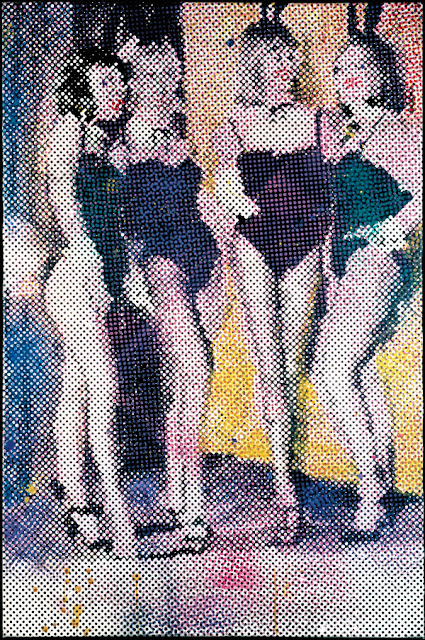59. SIGMAR
POLKE
 |
|
Bunnies 1966 Oil on canvas 150 x 100 cm
|
 |
|
Paganini 1982 Dispersion on canvas 200 x 450
cm
|
 |
| Wolldeckenbild mit kleinenweissen Quadraten 1968 Dispersion on wool blanket 150 x 125 cm |
BIO & STEPS
Life and Education:
He was born 1941 in Oels, Lower Silesia.
Upon his arrival in West Germany, in 1953, Polke began to
spend time in galleries and museums in Willich near Krefeld. He also worked as
an apprentice in a stained glass factory in Düsseldorf between 1959 and 1960,
before entering the Kunstakademie Düsseldorf (Arts Academy) at age twenty.
From 1961 to 1967 he
studied at the Düsseldorf Arts Academy under Karl Otto Götz, Gerhard Hoehme and
deeply influenced by his teacher Joseph Beuys. He began his creative output
during a time of enormous social, cultural, and artistic changes in Germany and
elsewhere. During the 1960s, Düsseldorf, in particular, was a prosperous,
commercial city and an important centre of artistic activity. In the early
1970s Polke lived at the Gaspelhof, an artists' commune.
From 1977–1991, he was a professor at the Academy of Fine
Arts, Hamburg. His students included, among others, Georg Herold. He settled in
Cologne 1978, where he continued to live and work until his death in June 2010
after a long battle with cancer.
Themes and style:
Polke
scrutinized the malleability of vision. Highly attuned to the differences
between appearance and reality, he was wary of the notion that there might be
one universal truth. His relentlessly inventive works, ranging in size from the
intimacy of a notebook to monumental paintings, collapse conventional
distinctions—between high culture and low, figuration and abstraction, the
heroic and the banal—allowing flux, rather than stability, to prevail.
Techniques:
Polke experimented with a wide range of
styles, subject matters and materials. In the 1970s, he concentrated on
photography, returning to paint in the 1980s, when he produced abstract works
created by chance through chemical reactions between paint and other products.
In the last 20 years of his life, he produced paintings focused on historical
events and perceptions of them.
Exhibitions
Polke
had his first one-person show at Galerie René Block, West Berlin, in 1966, and
in 1970 he had his first solo exhibition at Galerie Michael Werner, which would
subsequently represent the artist for the rest of his life.
His
first solo exhibition in New York, of paintings made at least a decade earlier,
was at the Holly Solomon Gallery in SoHo in 1982.
Following
a 1987 show at the Milwaukee Art Museum grouping Warhol, Beuys and Polke, the
Museum of Contemporary Art, Chicago mounted a solo show for Polke in 1991.
Polke exhibited at three documenta and several Venice Biennial exhibitions.
By the
latter years of his life, Polke's artistic achievements were being recognised
in large-scale exhibitions around the world, with solo shows at Tate Modern in
2003–2004, Tokyo's Ueno Royal Museum in 2005 and the Getty Center in Los
Angeles in 2007. In 2007, Vienna's "Museum Moderner Kunst" (MUMOK)
held an exhibition of Polke's work entitled "Sigmar Polke:
Retrospektive" that spanned his career from his appropriations of Pop
imagery and continuing through decades of perplexing compositions and clever
critiques to arrive at current works that employ a haze of chemicals, minerals,
and paints.
Also in
2007, Axial Age (2005–2007), a monumental cycle of paintings, was shown for the
first time at the 2007 Venice Biennale, with the wish explicitly expressed by
the artist that the work should remain on display in Venice. Polke is scheduled
to have a retrospective "Alibis: Sigmar Polke 1963–2010" shown at The
Museum of Modern Art in New York, from 19 April to 3 August 2014, then travels
to Tate Modern, London, United Kingdom and Museum Ludwig, Cologne, Germany.
Awards:
1964:
"Neodada Pop Decollage Kapitalistischer Realismus", Galerie René
Block, Berlin; Awarded the Young Germans award in Baden-Baden with Klaus
Geldmacher and Dieter Krieg
1975: Awarded
the prize for painting at the XIII Bienal de São Paulo
1986: Awarded a
“Golden Lion” at the XLII Biennale di Venezia (shared with Frank Auerbach)
1988: Awarded
the 1988 Baden-Württemberg International Prize for Painting
1994: Awarded
the "Erasmus Prize" (Amsterdam)
1995: Carnegie
Award at the Carnegie International, Pittsburgh, Pennsylvania
1998:
International Center of Photography, Infinity Award for Art; P.S.1 Contemporary
Art Center, New York
2000: Awarded
the "Kaiser Ring", Goslar, Germany
2002:
"Praemium Imperiale" awarded by the Japan Art Association, Tokyo
2007: Awarded
the "Rubens Prize" (Siegen, Germany)
2008: Foreign
Honorary Member in the Field of Visual Arts, American Academy of Arts and
Sciences
2009: Honorary
Member in the American Academy of Arts and Letters
2010: Awarded
the "Roswitha Haftmann Prize", Zurich
In his own words:
“I love all dots. I am married to many of
them. I want all dots to be happy. Dots are my brothers. I am a dot myself.”
Representative
Galleries:
Walker Art
Michel Werner
Saatchi
Skarstedt
David Zwirner
For
more Information:
http://www.moma.org/interactives/exhibitions/2014/polke/
En
español:
http://www.epdlp.com/pintor.php?id=2666
